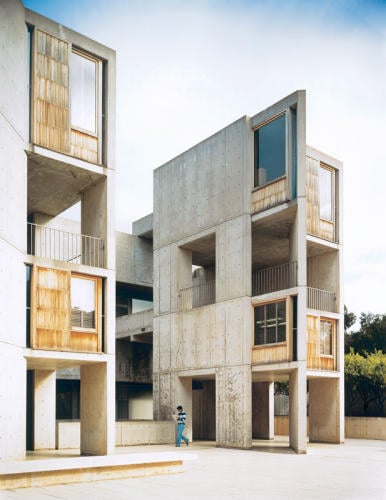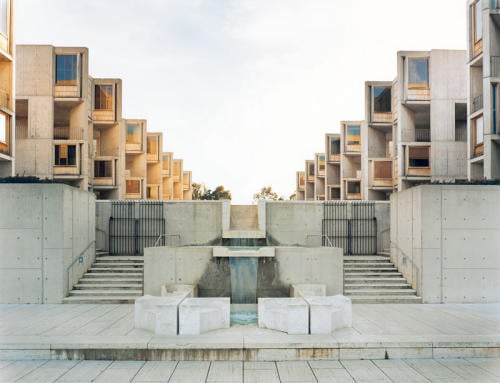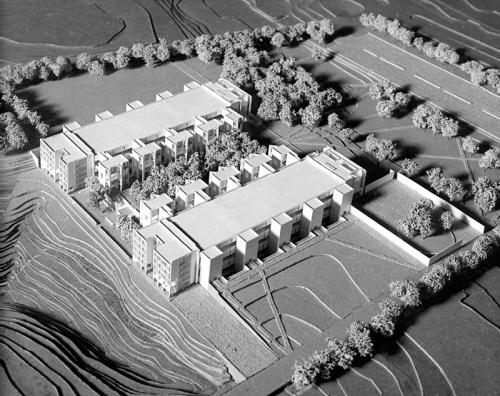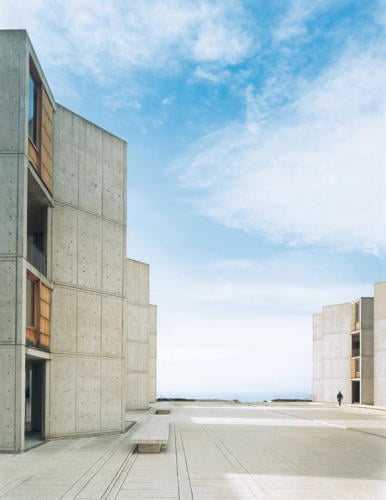
March 1, 2012
The Prose and Kahn of Designing an Architecture of Motherhood
My novel, Balancing Act, is an unusual intersection of architecture and motherhood. The primary question I pose is whether motherhood can be a life’s work in these modern times. I draw parallels between the protagonist, Tara Mistri’s, work of raising a family and Kahn’s built masterpiece, the Salk Institute. Tara’s journey is about how she […]
My novel, Balancing Act, is an unusual intersection of architecture and motherhood. The primary question I pose is whether motherhood can be a life’s work in these modern times. I draw parallels between the protagonist, Tara Mistri’s, work of raising a family and Kahn’s built masterpiece, the Salk Institute. Tara’s journey is about how she chooses between career and motherhood, informed by her analysis of her own life through the lens of her architectural training.
Architecture is central to the novel, both as Tara’s chosen field and as a metaphor for creating balance and structure in her life. At different times, by different people, the Salk is likened to both, a jewel and a soul-less building that might contain dentists’ offices. It is both sublime and profane, like life itself.
The book brings together many of my interests, and some subjects I feel passionately about – architecture, the built form and personal space, notions of feminism, the life and work of Louis Kahn, and the concept and implications of the creative life. In writing the novel, I learned more about architecture than I had ever known either as a student or as a practitioner. It brought me to the realization that architecture is not just a profession; it’s a way of life.
I didn’t know much about Louis I. Kahn when I began working on the novel, other than that he was born in Estonia and practiced in Philadelphia. He built in many parts of the US and in Dhaka and Ahmedabad. And that he died at Penn Station, returning from India and his body lay unclaimed for days. In order to research my subject, I immersed myself in the words and texts and lectures of Louis Kahn.
By a strange coincidence, just when I had begun restructuring the story by introducing the Salk Institute as a character in the novel, Nathaniel Kahn’s film, My Architect, was released. I pre-ordered the DVD and received it when I was half-way through reading Kahn’s Essential Lectures, word by painful word. I didn’t know until I watched the film that Kahn had led three separate lives, one within his marriage and two with other women with whom he also had families. Eventually, I used My Architect as the reference point to introduce Kahn into my story.
And I also got to know the Salk Institute. It helped that it was on way to my children’s pediatrician. I drove by it all the time, and soon I began driving to it, even when the children were well.
I began with a docent-led public tour, and later got a private tour with a scientist who was a mom at the children’s school. She walked me through her lab, and her office in the tower. To get a sense of her daily routine, I joined her on her walk through the barren, central plaza to the cafeteria at lunchtime. But I also experienced the space on my own, at various times of the day, in different seasons – La Jolla weather doesn’t change much other than going from perfect to more perfect – but the seasons affect the mood of the place. At Christmas time, you can see holly or festive decorations in the windows, and just after the New Year it is quiet and serene in mood though nothing is really different that you can identify visually. And over time, the place became familiar. Like a human being, a real person, someone close, on whose face you notice a new wrinkle or sense anger in the tightening of a jaw, similarly, I could see moods reflected on the surfaces of the Salk’s blank, pocked walls.
I could anticipate what shade of peach-pink they would be during a particularly spectacular sunset, and I began to notice where the untreated wood on the labs had worn out just a little more. Gradually, the Salk came to life. And over time, I could imagine other lives taking place here – and that’s how my protagonist, Tara became real. I could see her there.
To get into the head of your character, you have to be able to imagine how she might react, for example, when she’s berated for being a disgrace to feminism, or where she may choose to place the bricks she bakes. And in that sense I became her.
Here’s Tara as she gets ready to attend a dinner party:
I hated these parties where I was the only stay-at-home mom. Three whole hours standing around in fashionable clothes that felt so alien on my body now. Tying to mingle and join in conversations. Intelligent, interesting conversations that stopped, uncomfortably, mid-sentence, when I replied, as softly as possible, to the inevitable question, “What do you do?” There never seemed to be a follow-up like, “Did you hear Dick Cheney’s latest opinions on personal freedom?” or even, “What new fiction have you read recently?” No, the assumption was always, that my world did not extend beyond the Silly Putty and irrational, un-adult things.
This could not go on. Something had to change. Maybe tonight, I thought, I’ll give them a fifteen minute exposition on the deconstructivist tendencies of architectural iconography in the post-colonial, modernist world – and all that with a gurgling baby tied behind my back. (pp. 35)
An author must become all her characters. Writing fiction needs psychic space, to get in and out of character and place and time. You take what you know and what is identifiable and then mold it and transform it to become that which you imagine.
Similarly, when you design a building you have to imagine what it would be like to sit in a particular corner or how it might be when it’s raining. Nathaniel Kahn has spoken of buildings as stage sets. He said that as he filmed, gradually, he could imagine Lou imagining these places. As I read about Kahn, and walked through the Salk, it was clear that buildings are stage sets on which lives will unfold long after you’re done building them. And people may not behave in them, the way the designer may have intended. The days of Frank Lloyd Wright dictating how and where to place the furniture and what to wear when you’re in his buildings are long gone.
So one could say that buildings are inanimate and we animate them by our presence. But with Kahn’s buildings, I would suggest that they have such a monumental presence of their own, we are animated by them, transformed by them. And novels, stories, writing, can have a similar effect on people. People can be transformed by a certain book or character or writer.
This raises the question of ownership. That is, does it help to know the author in order to understand the text? Does the work not speak for itself, separate from the creator? I’ve often been asked about the similarities between me and Tara. We share professions, both have two children, and live(d) in San Diego, but so do a lot of women. Tara is me but she is also every other woman facing the dilemma of choosing between motherhood and career. Our stories may differ on details but in spirit, they are the same. Nathaniel Kahn was asked if knowing Lou through the film helped him to understand his buildings. He responded that knowing the architect may not help you to understand the architecture but it helps you feel it. That the buildings remained monumental to him, but his father became less of a myth.
The two are inextricably linked. In understanding what Jonas Salk asked of Kahn and the specifics of their client-architect relationship or knowing something of the financial or site constraints or how much Kahn was travelling then, what his influences were, or places he had seen, that certainly helped me to understand the design intent behind the Salk better. But the architect remained an enigma till I learned about his personal story.
It was obvious that Louis Kahn had a deep and profound respect for his clients and the institutions he designed. Architects who worked with Kahn in Ahmedabad or Dhaka inevitably express warmth towards him. In addition to awe, the clients seem to feel that Kahn designed buildings for them with a sense of responsibility and respect because he was there on an invitation. I have neither heard, nor can I imagine, a similar sentiment being expressed about Corbusier in Chandigarh.
Kahn was the man who asked, “What do you want to be, Brick?” A master-builder asked this most basic, voiceless, unassuming, traditional form what it wanted to be when he could have built the world out of any material he chose. And then answered for the brick, “Brick says, I would like an arch.”
This line is at the crux of my novel in many ways. I was so taken by the humility in Kahn’s question that it took me some time to understand the truth he was getting at in his answer. If you take any one brick away from an arch, there will be no arch, and yet, while the arch exists, each brick is still an individual brick. Not so with concrete. So, he also had a deep and profound respect for his building materials. Perhaps only in Hinduism do you see this concept, where one sees God in everything, even in a stone or brick.
So it was baffling to me that a person such as this, who could ask, “What do you want, Brick,” would not have asked of his son, “What do you want, Nathaniel?” I wondered how a person who had such an abiding respect for institutions would not have based his own life on these same values? What of the institutions of marriage and fatherhood? How did he create the serenity of his buildings through the confusion and chaos of his personal life? How did he separate the two? And how should we, now that he is gone?
Tara comes to this realization one evening:
“I hadn’t considered until then that my visual analysis of the Salk had very little to do with what the building meant to the scientists who spent most of their waking hours inside the labs. Their lives – the children, the spouses, the schedules, the resentments – went in with them. Unlike them, Kahn had kept all the failures and heartaches, the drama and disappointments of his life, separate from his work.
That’s what was here at the Salk. The search for a higher self-image, because the world outside was much too complicated and unstructured.
And I stepped, with trepidation, back into the wild and unruly natural landscape that lay in wait just beyond the deliberately undefined threshold of the Salk.” (pp. 133)
I had thought that like motherhood, the experience of architecture is universal. But I’m less sure of this now. There is definitely a cultural component to some elements of design. It depends on your point of view, it depends where you put the camera, as a film-maker might say. It certainly makes a huge difference, this point of view, to the narrative. In my novel, the story is told in the first person by Tara. In an earlier draft, I had written it in the third person. It would be entirely different told by her husband or a “working” friend. Similarly, I try to show that the interpretation of the Salk, indeed, the judgment of the Salk depends on who is making it. While for some it is the embodiment of perfection, for others it is merely reminiscent of their chiropractor’s office.
In a conversation between Janet, a scientist who works at the Salk, and Tara, Janet describes how she sees the Salk:
“What are you talking about? Concrete and teak don’t speak to me, Tara. I know it’s an architectural icon, but to me, this is a prison. And anyway, a building certainly can’t fix my marriage.” Janet tossed down the last of her coffee and crushed the paper cup with her manicured hands. “It’s not going to work, Tara. Things are so much more complex behind the concrete walls. The silence and serenity of this open space is a façade. You don’t see the cracks on the outside. You just think the building has weathered well. It’s inside the lab that you feel the glare from the window, the draft from the vent. Hear the test tubes shatter. Most of all, I’m just angry because I know there’s no real solution.”
Her words tumbled like stones into the unquiet abyss between us. (pp.131)
There are some cultural references in my book, set entirely in San Diego, which don’t translate in India. Similarly, the notion of an open kitchen may or may not work across cultures. Comfort levels with colors or materials may vary. The warm colors one usually associates with the tropics are a far cry from the blues and whites you’d typically encounter in a colder climate.
In this sense, Kahn’s work stands the test of both, time and place. That is what makes it universal. You can be a Muslim in Bangladesh but your Parliament House designed by a Jewish-American architect, moves you, decades after it is built.
Writer or architect, you must make a connection with your audience, your client. Your work must speak to them.
Tara explains what she sees in the Salk towards the end of the novel:
It’s just the way Kahn’s buildings are. They cannot be fully understood but on a very private and personal level. It seems to me that what makes the Salk Institute great is the uncompromising internal consistency in its design. That makes it perhaps not sexy or fashionable, but something vastly more valuable – timeless. And in that, it reflects what we all seek, be it in architecture, in motherhood, or in life – the joy that comes from knowing that no matter what our choices, if they are borne of our true natures, they will embody the universal truths that provide constancy in an ever-changing, confusing world. (p.225)
Ultimately, writing fiction, like architecture, is a massive act of imagination. You imagine something in your mind’s eye and then through bricks and mortar, as it were, or words, you recreate this image in the physical world so that others can have a glimpse into your vision. And yet, nobody will ever experience the Salk as Kahn imagined it. Nobody will imagine Tara the way she is in my mind, but it doesn’t matter because once written, she belongs to the reader. Once the building or writing is done, you hand it over to the world and then you lose ownership. You no longer have control over the creation. Not all that different from when a child flies the nest, perhaps. When judgment hour arrives, you may not be called to defend yourself.
Life, like architecture, is complex and contradictory, to paraphrase Robert Venturi. There’s no one right way of doing things. Where I want commitment you may want freedom, where Tara stays at home, you may want a career. Where I want enclosure, you may want an open plan. But it will ultimately all co-exist and we have to ensure that it coexists in harmony. Walter Gropius said, “Society needs a good image of itself. That is the job of the architect.”
No artist functions in a vacuum. No matter Picasso’s insistence that he had no influences, that he was always original, we are all products of our environment. In fact, it is critical to be a part of the culture and society you inhabit, especially as an architect. Kahn wanted to build the Salk as a place where Picasso would have liked to visit but also a place where the scientists would feel at home. Perhaps, artists who paint or sculpt can be aloof and interior, but not architects who by definition, belong to society.
The notion that only the “arts” are creative fields is increasingly becoming dated. Sure, an artist or musician is creative, but isn’t a mathematician or a physicist? One could even argue that they need to be even more creative to achieve excellence. At least, no matter what, architects have to accept some structural constraints, abide by the laws of nature. A physicist can question even those! So we as architects can learn from everyone, everywhere. A unique feature of the profession is that its true success is based on a multi-disciplinary understanding of the world.
Sometime in the mid 1800s, John Ruskin wrote, “No person who is not a great sculptor or painter can be an architect. If he is not a sculptor or painter, he can only be a builder.”
All this really means is that richness and depth comes from the need to be more, know more, want more and only then will you be able to give more. As an architect, the more you can have empathy for your clients, the more you can put yourself in their shoes, imagine their lives, imagine their lives in your imagined spaces, the more successful your design will be.
Because the thing is, what we bring to architecture is everything we know. The more varied our own experiences, the more open we are to absorbing influences from every field, the more it enriches our work. Or as Kahn put it, “Architecture creates a feeling of a world within a world.” You never really ever stop being an architect once you discover that architecture is a way of thinking; architecture is a way of life.
Meera Godbole-Krishnamurthy was born in Mumbai, lived in the Philippines, France, and many parts of the United States. She studied art and architecture at Oberlin College and Columbia University receiving her MArch from the University of Virginia in 1992. She has participated in writing workshops at Stanford University, the University of Iowa, UC San Diego, and the La Jolla Writers Conference. She was an adjunct at the NewSchool of Architecture and Design in San Diego. She lives in Mumbai with her husband, two children, and a well-travelled cat. Balancing Act is her first novel and explores themes of architecture, built space, the life and work of Louis Kahn, motherhood, and feminism.
For more information on the Salk Institute, see our February 2007 magazine feature on The Science Hall of Fame.









